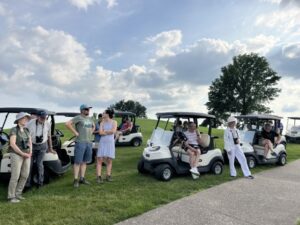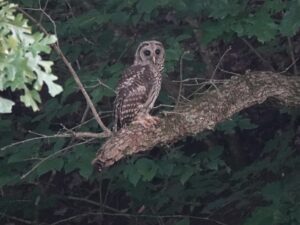Field Trip to A.L. Gustin Golf Course, a setting of natural communities
by Edge Wade
Twenty-four CAS members joined host Issac Breuer, Course Superintendent, for the June 16 field trip at the University of Missouri’s A.L. Gustin Golf Course. This was the third field trip at the golf course in a series begun at Mr. Breuer’s invitation a year ago as a kick-off to International Pollinators Week.
 In addition to fine birding (we saw 37 species in 1.5 hours), we learned of Mr. Breuer’s stewardship practices on the 125-acre course through establishing and caring for bird and pollinator-attractive habitat with 10-15 acres in planted plots, mostly seeded with a mix of 20 to 25 species called “Monarch Blend” contributed by MDC, Quail Forever, and other partners. His crew maintains martin houses (now all gourds as a deterrent to hawks that learned to pluck nestlings from the original houses), and bluebird houses (more than 4,000 bluebirds have fledged from those). The pond, surrounded by plantings of natural vegetation rather than grass, supports several Red-winged Blackbird nests and attracts occasional egret and heron visitors. Areas on the perimeter of the course bordering Flat Branch Creek and the MKT Trail have been left natural and, with the several mature oaks dotting the course, provide year-round habitat and are attractive to passerine migrants.
In addition to fine birding (we saw 37 species in 1.5 hours), we learned of Mr. Breuer’s stewardship practices on the 125-acre course through establishing and caring for bird and pollinator-attractive habitat with 10-15 acres in planted plots, mostly seeded with a mix of 20 to 25 species called “Monarch Blend” contributed by MDC, Quail Forever, and other partners. His crew maintains martin houses (now all gourds as a deterrent to hawks that learned to pluck nestlings from the original houses), and bluebird houses (more than 4,000 bluebirds have fledged from those). The pond, surrounded by plantings of natural vegetation rather than grass, supports several Red-winged Blackbird nests and attracts occasional egret and heron visitors. Areas on the perimeter of the course bordering Flat Branch Creek and the MKT Trail have been left natural and, with the several mature oaks dotting the course, provide year-round habitat and are attractive to passerine migrants.
It’s not just birds, bees and butterflies that benefit from the 10-15 acres of native habitat with maintenance requiring only burning or brush hogging every three years. The estimated $500 per acre saved relative to typical course management costs adds up to $5,000-$7,500 each year that is available for other uses to benefit the course and its golfers.
Golfers are long past complaining about the unkempt look and are proud of their special award-winning course. Mr. Breuer spreads the word about bird and pollinator-friendly course habitat potential and the benefits—both for the wildlife and financially—at course managers’ conferences, and encourages others to adopt some of the practices he’s using.
Our bird list this spring included Red-tailed and Red-shouldered hawks, a Mississippi Kite, 14 Eastern Bluebirds, a Great-crested Flycatcher, and Scarlet and Summer Tanagers. But most would agree that the two Barred Owls were the highlight.
We’ve requested that the course be listed as an eBird hotspot, designated as A.L. Gustin Golf Course (restricted access), and are hoping to continue the series with a fall field trip to see birds in fall migration and catch up with the developments in bird-friendly habitat management overseen by Mr. Breuer.

